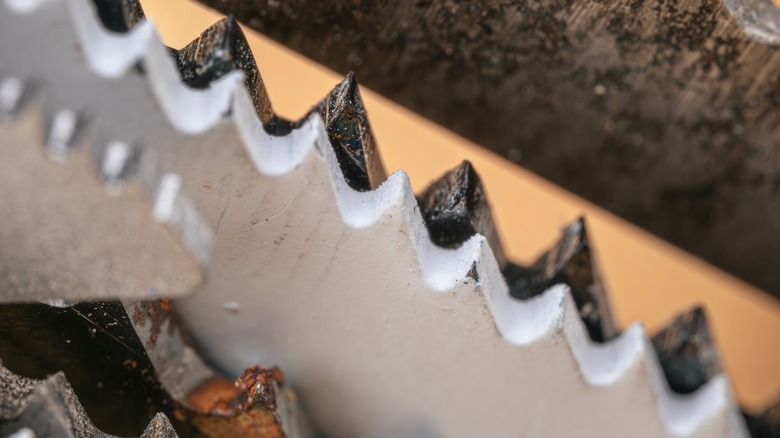The Jigsaw Blade Trick That Makes Cutting Small Notches So Much Easier
Did you know there's a jigsaw blade trick that makes cutting small notches much easier? If you've ever had to cut a small notch out of wood with a jigsaw, you know it can be awkward trying to keep the tool's blade steady and close to your marked line. Of course, the usual approach involves pushing the jigsaw away from you, which works well in open spaces but can get frustrating in tighter situations. Here's where a simple trick can help: flipping the blade around. Turning your jigsaw blade to face the opposite direction allows you to pull the tool toward you rather than push it away. This provides better visibility and control for detailed or restricted cuts. This one minor adjustment makes it far easier to follow your lines precisely, especially for tight cuts like toe kicks or corner joints that need to stay within a few millimeters of a nearby edge.
For best results, you'll still want to use a speed square or other guide for perfectly straight cuts, but changing the blade's direction unlocks added precision. It's a small switch that makes a big difference when working in cramped spots or cutting notches at the bottom of large pieces that are difficult to flip around. However, not every jigsaw or blade supports this trick, so be sure to double-check your tool's specifications first. After that, once you're ready to get woodworking, here are 12 amazing home DIY projects you can create with a jigsaw tool.
Why reversing your jigsaw blade is a tool game-changer
Once you've marked your cut, the traditional method would have you plunge the jigsaw blade straight down and push away along the outline. But that can cause you to overshoot your line if the saw drifts, or if your workspace forces you to cut at an awkward angle. Instead, flipping the blade 180 degrees lets you pull the jigsaw toward your body while maintaining better leverage, control, and sightlines. It's a smarter method for small detail work that benefits from a slower, guided hand, and it also helps when you need to get the saw flush up against a wall or a tight frame edge. Pulling the blade across the surface like this lets you sneak into corners with less wobble and greater confidence.
You don't need to be an expert woodworker to make the most of this technique. It's perfect for hobbyists exploring projects such as these 45 woodworking projects that even beginners can do. That said, any time you're adjusting power tools in non-standard ways, even for something as minor as a blade flip, it's important to refresh your safety knowledge. Tools behave differently when pushed versus pulled, so check your grip, footing, and blade tightness. And always follow the woodworking safety precautions you should take for your next home project. When done right, this reversed-blade trick can simplify your cuts while improving the results. Just remember that finesse, not force, is the name of the game.
